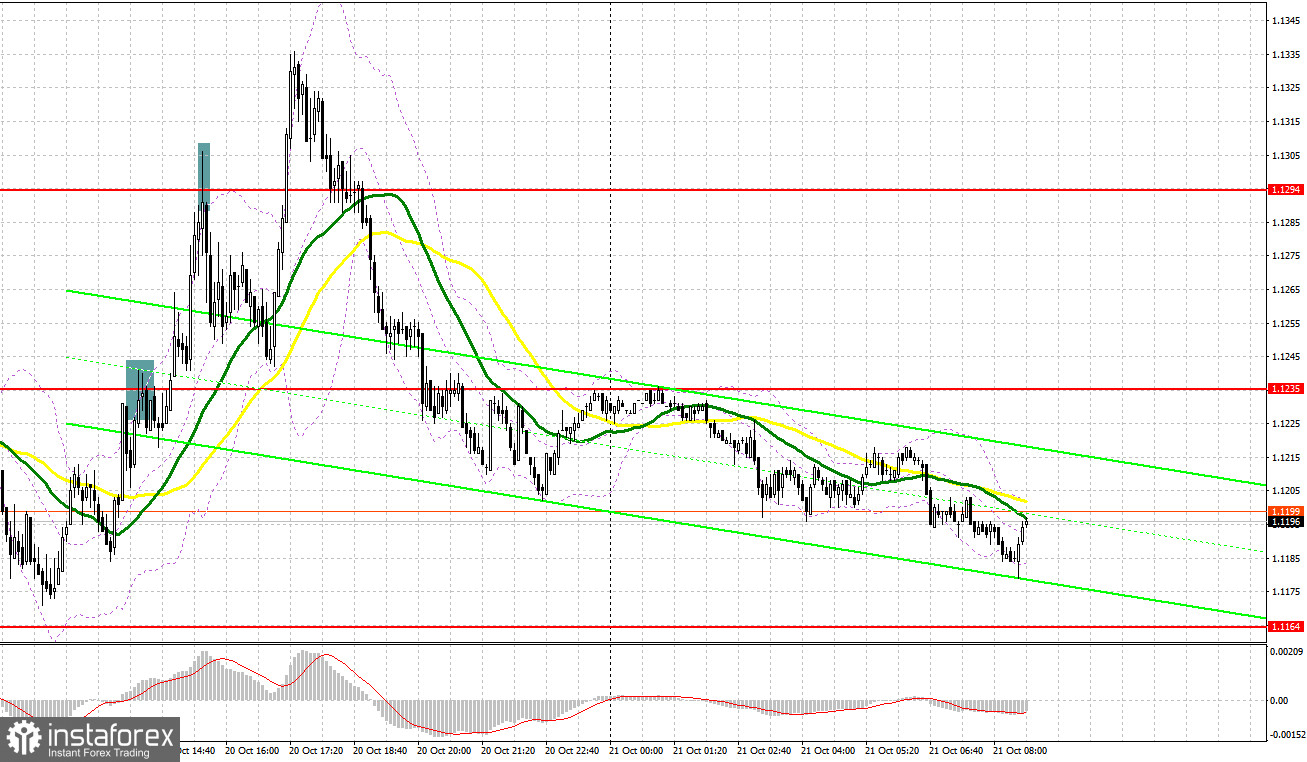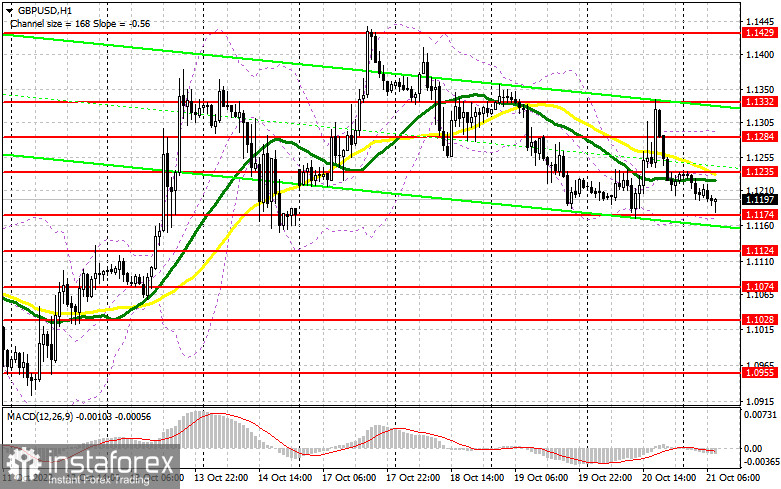Yesterday, several market entry signals were formed, but not all of them turned out to be profitable. Let's take a look at the 5-minute chart and figure out what happened. I paid attention to the 1.1192 level in my morning forecast and advised making decisions on entering the market there. The decline and false breakout in this range led to a buy signal, but it has not yet reached a strong growth. Obviously, there is no one willing to sell at the lows, and they are also not ready to bet on the further strengthening of the British pound. In the afternoon, one could observe an unsuccessful attempt to break through 1.1235 as well as a sell signal, however, there was no downward movement, which led to losses. In the middle of the US session, an unsuccessful attempt to consolidate above 1.1294 led to the entry point into short positions, which caused the pound to move down by 50 points.

When to go long on GBP/USD:
British Prime Minister Liz Truss resigned, which resulted in the pound's growth and a surge in volatility. However, "the music did not play for long", and towards the end of the day the bears, taking advantage of attractive prices, returned the pair back to the horizontal channel. Today we will have a number of statistics on the change in the volume of retail trade, taking into account fuel costs in the UK and public sector net leverage. It is obvious that no matter what the data on retail sales are, most likely the pound will react negatively to them. A decline in sales is bad for the economy, and their growth will lead to even greater inflationary pressure, which at the moment will put more pressure on the Bank of England, which is actively fighting against rising prices.
Therefore, in case GBP/USD falls, forming a false breakout at the level of 1.1174 will provide a signal to buy with the goal of returning to 1.1235 – an important resistance formed on the basis of yesterday. A breakout and a downward test of this range can radically change the situation, allowing bulls to fully compensate for all of yesterday's losses, pulling stop orders from speculators. This forms a new buy signal with growth towards the more important level at 1.1284. The most distant target will be a high of 1.1332 – the upper limit of the new horizontal channel. If the bulls fail to cope with their tasks and miss 1.1174, the pressure on the pair will quickly return, which will lead to new active short positions on the pound. In this case, I advise you to buy only on a false breakout in the area of 1.1124. I recommend opening long positions on GBP/USD immediately for a rebound from 1.1074, or even lower - around 1.1028 with the goal of correcting 30-35 points within the day.
When to go short on GBP/USD:
The bears are quite confident, cooling the ardor of speculative bulls who decided to take advantage of the news about the prime minister's resignation. The best scenario for selling today, of course, would be a false breakout in the resistance area of 1.1235, where the moving averages are, playing on the bears' side. This will make it possible for us to get a good entry point with the goal of moving to the nearest support at 1.1174, on which quite a lot depends. A breakthrough and test from the bottom up of this range would be a good setup with an exit to the 1.1124 low. The farthest target will be the area of 1.1074, where I recommend taking profits.
In case GBP/USD grows and the bears are not active at 1.1235, the bulls will continue to return to the market, counting on offsetting the situation, finally locking the pair in the horizontal channel. This will push the GBP/USD to the 1.1284 area. Only a false breakout at this level will provide an entry point into short positions with the goal of a new decline. If traders are not active there, I advise you to sell GBP/USD immediately for a rebound from 1.1332, counting on the pair's rebound down by 30-35 points within the day.

COT report:
The Commitment of Traders (COT) report for October 11 logged a sharp reduction in short positions and an increase in long positions. The Bank of England's intervention has affected many traders who are now betting on the strengthening of the pound in the medium term. More recently, it was reported that the central bank has decided to temporarily suspend its quantitative tightening program, better known as QT, to help the bond market recover a bit after a sharp collapse caused by the actions of British Prime Minister Liz Truss. However, one should not count on a sharp rise in the pound in the medium term, as there is an economic recession and an aggressive policy on the part of the Federal Reserve, which will make the US dollar more attractive. The latest COT report indicated that long non-commercial positions rose by 6,901 to 48,979, while short non-commercial positions decreased by 3,468 to 88,149, resulting in a slight reduction in the negative non-commercial net position to -39,170 versus -49,539. The weekly closing price dropped to 1.1036 versus 1.1494.

Signals of indicators:
Trading is below the 30 and 50-day moving averages, which indicates an attempt by the bears to take over the market.
Moving averages
Note: The period and prices of moving averages are considered by the author on the H1 chart, which differs from the general definition of the classic daily moving averages on the daily chart.
Bollinger Bands
In case of a decline, the lower border of the indicator around 1.1174 will act as support.
Description of indicators
- Moving average (moving average, determines the current trend by smoothing out volatility and noise). Period 50. It is marked in yellow on the chart.
- Moving average (moving average, determines the current trend by smoothing out volatility and noise). Period 30. It is marked in green on the chart.
- MACD indicator (Moving Average Convergence/Divergence — convergence/divergence of moving averages) Quick EMA period 12. Slow EMA period to 26. SMA period 9
- Bollinger Bands (Bollinger Bands). Period 20
- Non-commercial speculative traders, such as individual traders, hedge funds, and large institutions that use the futures market for speculative purposes and meet certain requirements.
- Long non-commercial positions represent the total long open position of non-commercial traders.
- Short non-commercial positions represent the total short open position of non-commercial traders.
- Total non-commercial net position is the difference between short and long positions of non-commercial traders.
 English
English 
 Русский
Русский Bahasa Indonesia
Bahasa Indonesia Bahasa Malay
Bahasa Malay ไทย
ไทย Español
Español Deutsch
Deutsch Български
Български Français
Français Tiếng Việt
Tiếng Việt 中文
中文 বাংলা
বাংলা हिन्दी
हिन्दी Čeština
Čeština Українська
Українська Română
Română

